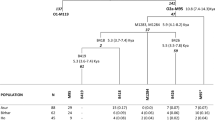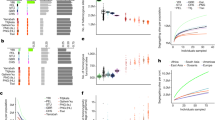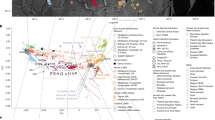Abstract
The Nicobarese are the major tribal groups in the Nicobar district, situated south of the Andaman group of Islands. Linguistic phylogeny suggests that the linguistic ancestors of the Nicobarese settled the Nicobar archipelago in the early Holocene. So far, genetic research on them is low-resolution and restricted to the haploid DNA markers. Therefore, in the present analysis, we have used the high-resolution biparental (1554 published and 5 newly genotyped Nicobarese individuals) and uniparental genetic markers and looked at the genetic association of Nicobarese with the South and Southeast Asian populations. We report a common ancestral component shared among the Austroasiatic of South and Southeast Asia. Our analyses have suggested that the Nicobarese peoples retain this ancestral Austroasiatic predominant component in their genomes in the highest proportion. On the Southeast Asian mainland, the Htin Mal, who speak an Austroasiatic language of the Khmuic branch, represent a population that has preserved their ethnic distinctness from other groups over time and consequently shown the highest drift with the Nicobarese. The analysis based on haplotypes indicated a significant level of genomic segment sharing across linguistic groups, indicating an ancient broader distribution of Austroasiatic populations in Southeast Asia. Based on the temporal analyses of haploid DNA, it is suggested that the forebears of the Nicobarese people may have arrived on the Nicobar Islands in the last 5000 YBP. Therefore, among the modern populations, the Nicobarese peoples and the Htin Mal language community represent good genetic proxies for ancient Austroasiatics.
This is a preview of subscription content, access via your institution
Access options
Subscribe to this journal
Receive 12 print issues and online access
$259.00 per year
only $21.58 per issue
Buy this article
- Purchase on SpringerLink
- Instant access to full article PDF
Prices may be subject to local taxes which are calculated during checkout





Similar content being viewed by others
Data availability
The data is available on request to the corresponding author.
References
Mason F. The Talaing language. J Am Orient Soc. 1854;4:277–88.
Schmidt W. Die Mon-Khmer-völker: ein bindeglied zwischen völkern Zentralasiens und Austronesiens. Arch Anthropol. 1906;V:59–109.
Skeat WW, Blagden CO. Pagan races of the Malay peninsula (two vols.). London: Macmillan and Company; 1906.
von Heine-Geldern R. Kopfjagd und Menschenopfer in Assam und Birma und ihre Ausstrahlungen nach Vorderindien. Mitteilungen Anthropol Ges Wien. 1917;XXXVII:1–65.
Adelaar KA. Borneo as a cross-roads for comparative Austronesian linguistics. The Austronesians: historical and comparative perspectives. Canberra: Australian National University, 1995. p. 75–95.
Blust R. The greater north Borneo hypothesis. Ocean Linguist. 2010;49:44–118.
Trejaut JA, Poloni ES, Yen J-C, Lai Y-H, Loo J-H, Lee C-L, et al. Taiwan Y-chromosomal DNA variation and its relationship with Island Southeast Asia. BMC Genet. 2014;15:1–23.
HUGO Pan-Asian SNP Consortium, Abdulla MA, Ahmed I, Assawamakin A, Bhak J, Brahmachari SK, et al. Mapping human genetic diversity in Asia. Science. 2009;326:1541–5.
Cœdès G. Le royaume de Çrīvijaya. Bull l’École Française d’Extrême-Orient, 1918;18:1–36.
Geiger W. The Mahāvaṃsa or the Great Chronicle of Ceylon. London: Pali Text Society; 1912.
Diffloth G. The contribution of linguistic palaeontology to the homeland of Austroasiatic. The Peopling of East Asia: putting together the archaeology, linguistics and genetics. London: Routledge Curzon; 2005. p. 77–80.
Lipson M, Loh P-R, Patterson N, Moorjani P, Ko Y-C, Stoneking M, et al. Reconstructing Austronesian population history in island Southeast Asia. Nat Commun. 2014;5:4689.
Lipson M, Cheronet O, Mallick S, Rohland N, Oxenham M, Pietrusewsky M, et al. Ancient genomes document multiple waves of migration in Southeast Asian prehistory. Science. 2018;361:92–5.
Wang C-C, Yeh H-Y, Popov AN, Zhang H-Q, Matsumura H, Sirak K, et al. Genomic insights into the formation of human populations in East Asia. Nature. 2021;591:413–9.
McColl H, Racimo F, Vinner L, Demeter F, Gakuhari T, Moreno-Mayar JV, et al. The prehistoric peopling of Southeast Asia. Science. 2018;361:88–92.
Chaubey G, Metspalu M, Choi Y, Mägi R, Romero IG, Soares P, et al. Population genetic structure in Indian Austroasiatic speakers: the role of landscape barriers and sex-specific admixture. Mol Biol Evol. 2011;28:1013.
ArunKumar G, Tatarinova TV, Duty J, Rollo D, Syama A, Arun VS, et al. Genome-wide signatures of male-mediated migration shaping the Indian gene pool. J Hum Genet. 2015;60:493–9.
Tätte K, Pagani L, Pathak AK, Kõks S, Duy BH, Ho XD, et al. The genetic legacy of continental scale admixture in Indian Austroasiatic speakers. Sci Rep. 2019;9:1–9.
Rau F, Sidwell P. The Munda maritimehypothesis. Journal of the Southeast Asian Linguistics Society, 2019;12:35–57.
Tripati S, Prabhu G, Patnaik SK, Acharya SK, Mishra UK, Behera RP, et al. A preliminary study of knobbed ware from Odisha. Man Env. 2019;LXIV:82–9.
Singh PP, Vishwakarma S, Sultana GNN, Pilvar A, Karmin M, Rootsi S, et al. Dissecting the paternal founders of Mundari (Austroasiatic) speakers associated with the language dispersal in South Asia. Eur J Hum Genet. 2021;29:528–32.
Prasad BV, Ricker CE, Watkins WS, Dixon ME, Rao BB, Naidu JM, et al. Mitochondrial DNA variation in Nicobarese Islanders. Hum Biol Int Rec Res. 2001;73:715–25.
Thangaraj K, Singh L, Reddy AG, Rao VR, Sehgal SC, Underhill PA, et al. Genetic affinities of the Andaman Islanders, a vanishing human population. Curr Biol CB. 2003;13:86–93.
Thangaraj K, Sridhar V, Kivisild T, Reddy AG, Chaubey G, Singh VK, et al. Different population histories of the Mundari-and Mon-Khmer-speaking Austro-Asiatic tribes inferred from the mtDNA 9-bp deletion/insertion polymorphism in Indian populations. Hum Genet. 2005;116:507–17.
Chang CC, Chow CC, Tellier LC, Vattikuti S, Purcell SM, Lee JJ. Second-generation PLINK: rising to the challenge of larger and richer datasets. GigaScience. 2015;4:1–16.
Nakatsuka N, Moorjani P, Rai N, Sarkar B, Tandon A, Patterson N, et al. The promise of discovering population-specific disease-associated genes in South Asia. Nat Genet. 2017;49:1403.
Patterson N, Price AL, Reich D. Population structure and eigenanalysis. PLoS Genet. 2006;2:e190.
Soares PA, Trejaut JA, Rito T, Cavadas B, Hill C, Eng KK. Resolving the ancestry of Austronesian-speaking populations. Hum Genet. 2016;135. https://doi.org/10.1007/s00439-015-1620-z.
Reich D, Thangaraj K, Patterson N, Price AL, Singh L. Reconstructing Indian population history. Nature. 2009;461:489–94.
International HapMap C. A haplotype map of the human genome. Nature. 2005;437:1299–320.
Patterson N, Moorjani P, Luo Y, Mallick S, Rohland N, Zhan Y, et al. Ancient admixture in human history. Genetics. 2012;192:1065–93.
Lawson DJ, Hellenthal G, Myers S, Falush D. Inference of population structure using dense haplotype data. PLoS Genet. 2012;8:e1002453.
Singh PP, Suravajhala P, Basu Mallick C, Tamang R, Rai AK, Machha P et al. COVID-19: Impact on linguistic and genetic isolates of India. Genes Immun. 2021;23:47–50.
Thangaraj K, Chaubey G, Kivisild T, Reddy AG, Singh VK, Rasalkar AA, et al. Reconstructing the origin of Andaman Islanders. Science. 2005;308:996.
Sitalaximi T, Varghese N, Kashyap V. Genetic differentiation of Andaman Islanders and their relatedness to Nicobar Islanders. Hum Gene. 2023;35:201148.
Bouckaert R, Vaughan TG, Barido-Sottani J, Duchêne S, Fourment M, Gavryushkina A, et al. BEAST 2.5: an advanced software platform for Bayesian evolutionary analysis. PLoS Comput Biol. 2019;15:e1006650.
Silva M, Oliveira M, Vieira D, Brandão A, Rito T, Pereira JB, et al. A genetic chronology for the Indian Subcontinent points to heavily sex-biased dispersals. BMC Evol Biol. 2017;17:88.
Soares P, Ermini L, Thomson N, Mormina M, Rito T, Rohl A, et al. Correcting for purifying selection: an improved human mitochondrial molecular clock. Am J Hum Genet. 2009;84:740–59.
Nazir S, Adnan A, Rehman RA, Al-Qahtani WS, Alsaleh AB, Al-Harthi HS, et al. Mutation rate analysis of RM Y-STRs in deep-rooted multi-generational Punjabi Pedigrees from Pakistan. Genes. 2022;13:1403.
Oven M. PhyloTree Build 17: Growing the human mitochondrial DNA tree. Forensic Sci Int Genet. 2015;5. https://doi.org/10.1016/j.fsigss.2015.09.155.
Blagden CO. From central India to Polynesia: a new linguistic synthesis. J Straits Branch R Asiat Soc. 1909;53:163–73.
Anderson A. Crossing the Luzon Strait: archaeological chronology in the Batanes Islands, Philippines and the regional sequence of Neolithic dispersal. J Austronesian Stud. 2005;1:25–45.
Poppe N. Introduction to Altaic linguistics. Wiesbaden: Otto Harrassowitz; 1965.
Benedict PK. Sino-Tibetan: a conspectus. Cambridge: Cambridge University Press; 1972.
Hashimoto M. Language diffusion on the Asian continent: Problems of typological diversity in Sino-Tibetan. Comput Anal Asian Afr Lang. 1976;3:49–65.
Hashimoto M. The agrarian and the pastoral diffusion of language. Genet Relatsh Diffus Typol Similarities East Southeast Asian Lang. 1976;1–14.
Norman J. Four notes on Chinese-Altaic linguistic contacts. Tsing Hua J Chin Stud. 1982;14:243–7.
van Driem GL. Ethnolinguistic prehistory: The peopling of the world from the perspective of language, genes and material culture. Brill, 2021.
van Driem G. The creoloid origins ofChinese. Bhāṣā: Journal ofSouth Asian Linguistics, Philology and Grammatical Traditions, 2022;1:239–261.
Karmin M, Saag L, Vicente M, Sayres MAW, Järve M, Talas UG, et al. A recent bottleneck of Y chromosome diversity coincides with a global change in culture. Genome Res. 2015;25:459–66.
Chaubey G, van Driem G. Munda languages are father tongues, but Japanese and Korean are not. Evol Hum Sci, 2020;2:e19.
Acknowledgements
RKM is supported by Malaviya-PDF (IoE/MPDF/2020-21) grant. NR is supported by SERB-CRG/20-21/006762 and In-House BSIP Institutional Project No. 7.3 also NR is thankful to Director, BSIP Lucknow for providing the laboratory support. GC is supported by ICMR ad-hoc grants (2021-6389), (2021-11289) and BHU IoE incentive grant BHU (6031). PPS is supported by the RJP-PDF grant of Banaras Hindu University. SD is supported by the CSIR-JRF fellowship. KT is supported by the Department of Science and Technology, Government of India (JCB/2019/000027).
Funding
The research is supported by ICMR ad-hoc grants (2021-6389).
Author information
Authors and Affiliations
Contributions
KT, GC, and GvD designed and supervised the study. KT collected the samples. RKM, PPS, NR, SD, PP, SKT, RT, PrS, and PS collected the anthropological information. PPS, NR, and RT performed Affymatrix genotyping. RKM, PPS, NR, SD, PP, SKT, GC, RT, PrS, and PS performed data analysis and interpretations. RKM, PPS, GC, GvD, and KT wrote the manuscript with inputs from other co-authors.
Corresponding authors
Ethics declarations
Competing interests
The authors declare no competing interests.
Ethical approval
This study is ethically approved by the institutional ethical committee of Banaras Hindu University, Varanasi and CSIR-CCMB, Hyderabad.
Additional information
Publisher’s note Springer Nature remains neutral with regard to jurisdictional claims in published maps and institutional affiliations.
Rights and permissions
Springer Nature or its licensor (e.g. a society or other partner) holds exclusive rights to this article under a publishing agreement with the author(s) or other rightsholder(s); author self-archiving of the accepted manuscript version of this article is solely governed by the terms of such publishing agreement and applicable law.
About this article
Cite this article
Mishra, R.K., Singh, P.P., Rai, N. et al. Reconstructing the population history of the Nicobarese. Eur J Hum Genet (2024). https://doi.org/10.1038/s41431-024-01720-w
Received:
Revised:
Accepted:
Published:
DOI: https://doi.org/10.1038/s41431-024-01720-w
This article is cited by
-
Looking back at 2024 in the European Journal of Human Genetics
European Journal of Human Genetics (2025)
-
Ancient Austroasiatic roots of Nicobarese revealed
Nature India (2024)



